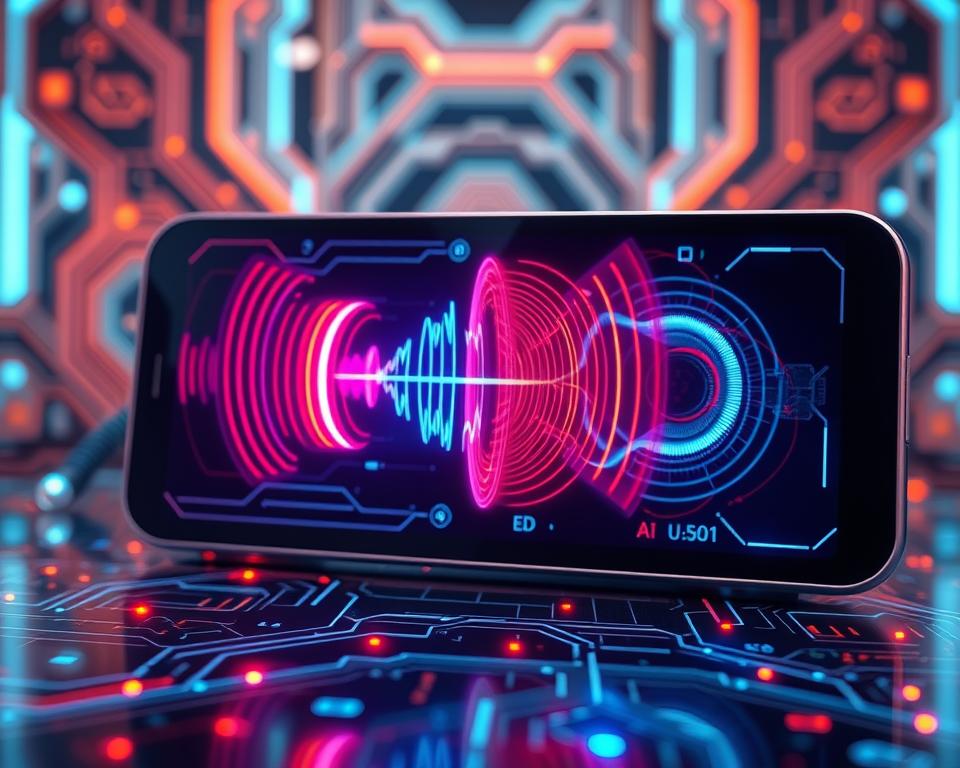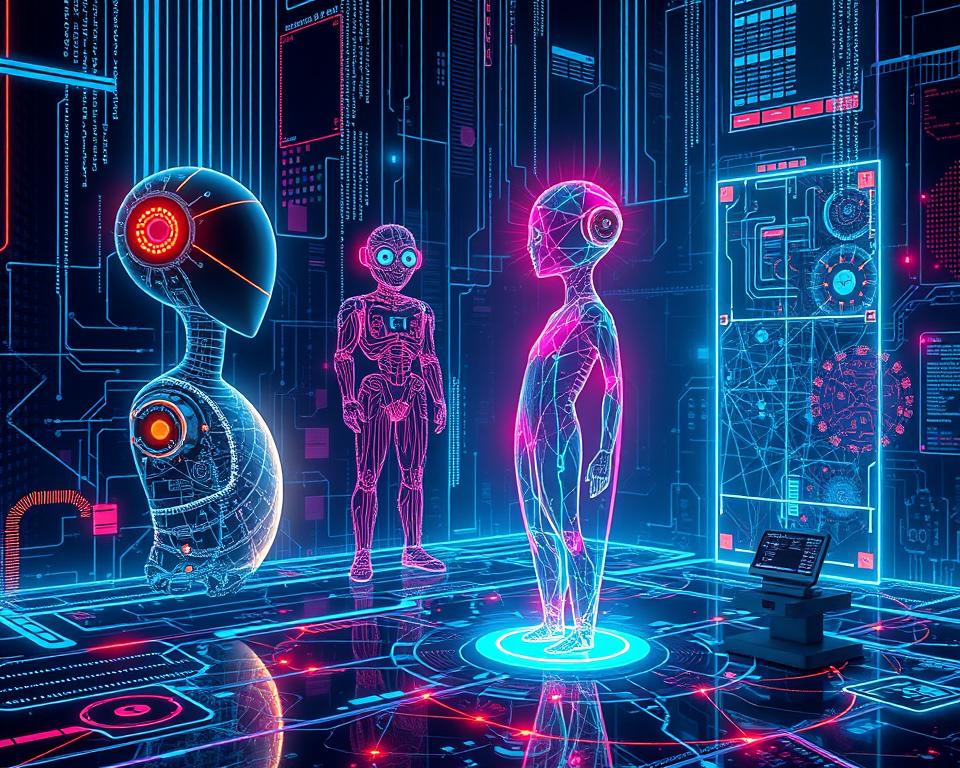Ever thought about what “Full Self-Driving” really means in a car? As we dive into Tesla FSD technology, it’s key to understand that it’s not fully autonomous. It still needs the driver to keep an eye on things. Tesla cars are changing the way we think about driving, but the details of their Full Self-Driving tech can be tricky. Let’s look at what makes Tesla’s approach to the future of driving both exciting and cautious.
Introduction to Tesla and its Self-Driving Vision
Tesla leads in electric vehicles and self-driving tech. I’m drawn to its innovative cars and bold goal to change how we travel. Tesla aims for a future where cars drive themselves, making roads safer and more convenient.
CEO Elon Musk believes in the power of self-driving cars. He wants to make driving smooth and error-free. This vision has sparked talks on how such tech will change our roads.
The progress in self-driving cars is exciting, but it raises important questions. We need to talk about rules and ethics. It’s key to make sure these cars are safe and right for our society. As Tesla moves forward, we must keep discussing how to make self-driving tech work for everyone.

What is Tesla FSD and How Does It Really Work
Tesla’s Full Self-Driving (FSD) is a big step forward in driving tech. It brings a lot of automated features to make driving better. It’s important to understand how it works and its potential for the future of driving.
Understanding Full Self-Driving Capabilities
The Tesla FSD has many features like traffic light recognition and self-parking. It’s called full self-driving, but drivers still need to be ready to take control if needed. Tesla cars are great at handling tough driving situations, showing how well they work in real life.
Components and Technologies Behind FSD
The heart of Tesla FSD is a mix of advanced hardware and software, especially neural networks. This new approach helps the system learn and adapt from real-world data. The goal is to make driving technology better, aiming for more autonomous cars in the future.

The Evolution of Tesla’s Autonomy Features
Tesla’s journey with autonomous features is a story of change in driving tech. It began with Tesla Autopilot in 2014, aiming to change how we drive. Over time, it moved from basic features to the advanced Full Self-Driving (FSD) package. This shows Tesla’s focus on safety and innovation.
From Autopilot to Full Self-Driving
Tesla Autopilot started in 2014, a key moment for Tesla’s FSD history. It brought adaptive cruise control and lane-keeping to the road. By 2016, Enhanced Autopilot added more features for highway and city driving.
Recently, Tesla introduced Full Self-Driving. This shows Tesla’s push towards an autonomous future.
Historical Milestones in Tesla’s Autonomous Journey
Key events have shaped Tesla’s path to autonomy. Autopilot’s launch in 2014 set the stage, followed by Enhanced Autopilot in 2016. Then, in 2020, the FSD beta program marked a big step towards full autonomy.
Each step highlights Tesla’s drive for innovation. It also sparks talks on safety and the limits of autonomous tech.
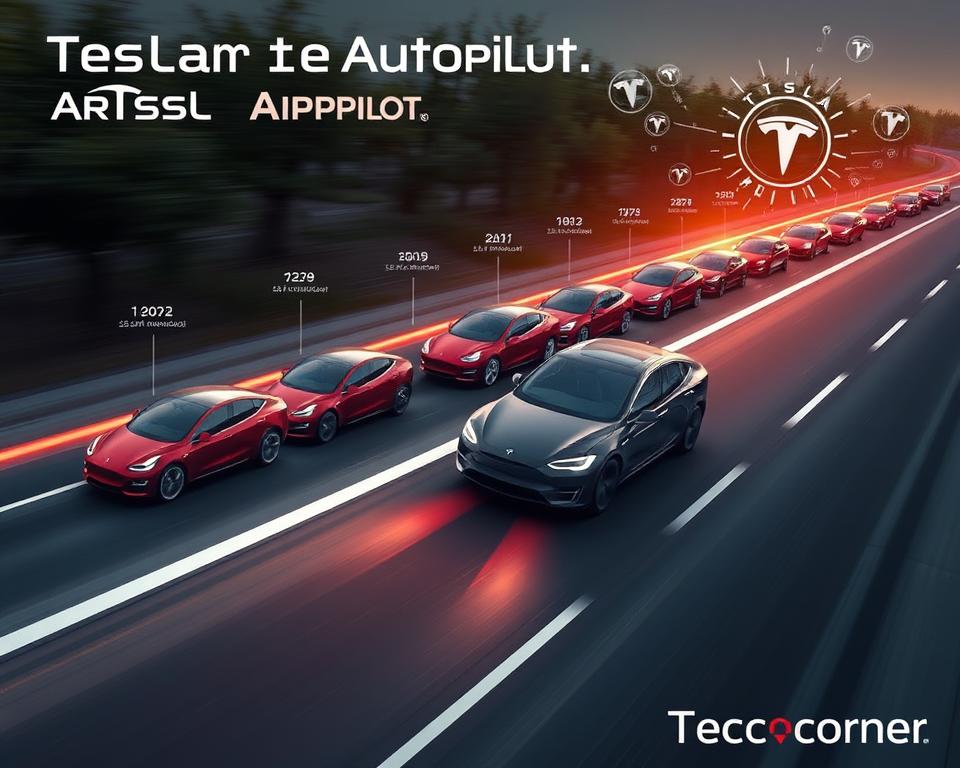
| Year | Milestone | Description |
|---|---|---|
| 2014 | Launch of Autopilot | Introduction of adaptive cruise control and lane-keeping features. |
| 2016 | Enhanced Autopilot | Added capabilities for highway navigation and basic urban features. |
| 2020 | FSD Beta Testing | Initiation of Full Self-Driving beta, taking a significant step toward autonomy. |
Current Features and Functions of Tesla’s FSD
Tesla’s Full Self-Driving (FSD) system has many cool features to make driving better. It shows Tesla’s dedication to innovation. They aim to improve safety and make driving easier.
Basic Autopilot Capabilities
The Basic Autopilot package is the starting point for Tesla’s tech. It includes lane-centering and traffic-aware cruise control. These features help make driving safer and reduce driver fatigue on long trips.
Enhanced Autopilot and Full Self-Driving Functions
Enhanced Autopilot adds more cool stuff to the mix. You get automatic lane changes, self-parking, and better highway navigation. These features make driving easier and safer.
With each software update, Tesla’s FSD gets even better. It keeps up with new safety rules and tech. This keeps Tesla leading in self-driving innovation.
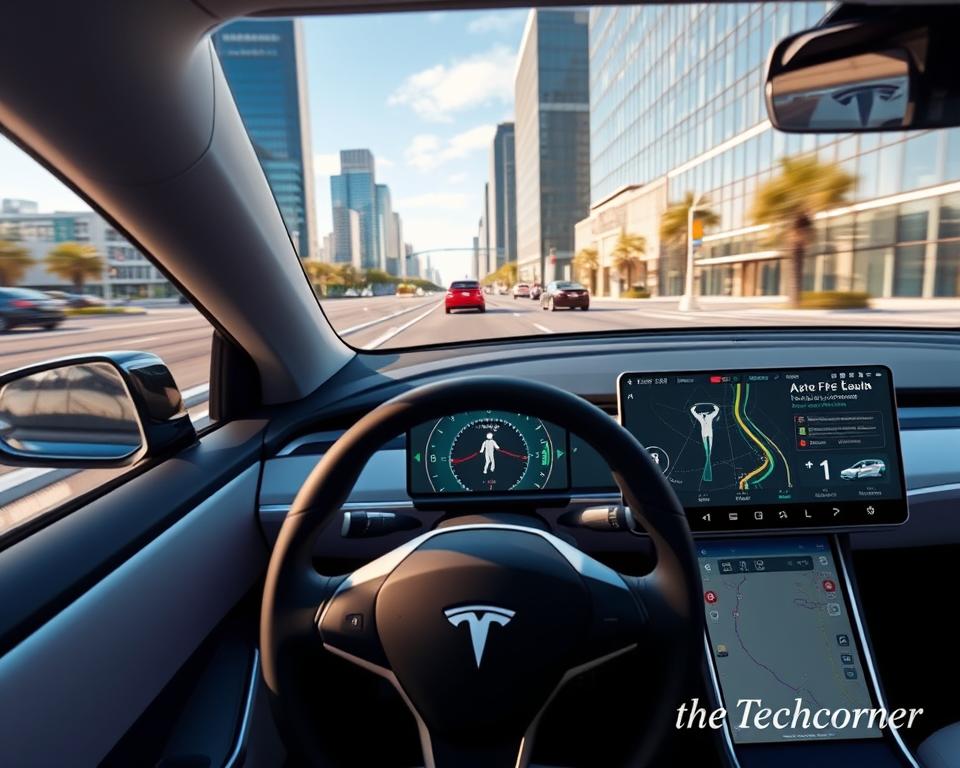
Costs and Accessibility of Tesla’s FSD
Tesla’s FSD pricing is key for those looking to buy or upgrade. Getting the Full Self-Driving package costs about $15,000. For flexibility, there are monthly subscription options for different packages. This lets users try out FSD’s new features and pay based on their needs.
Pricing Structure and Payment Options
It’s important to know about Tesla FSD pricing and payment methods. Here are the main ways to pay:
- Upfront Payment: Pay about $15,000 once for full access.
- Monthly Subscription: Choose from various rates based on your package.
- Upgrades: Pay for new updates as Tesla adds more features.
FSD Availability Based on Vehicle Models
Not all Teslas can get FSD, so it’s key to check compatibility. Models made after 2016 with the right hardware can get FSD. Knowing which models can use FSD is important:
| Tesla Model | Year Introduced | FSD Eligible |
|---|---|---|
| Model S | 2016 | Yes |
| Model 3 | 2017 | Yes |
| Model X | 2016 | Yes |
| Model Y | 2020 | Yes |
| Older Models | Before 2016 | No |
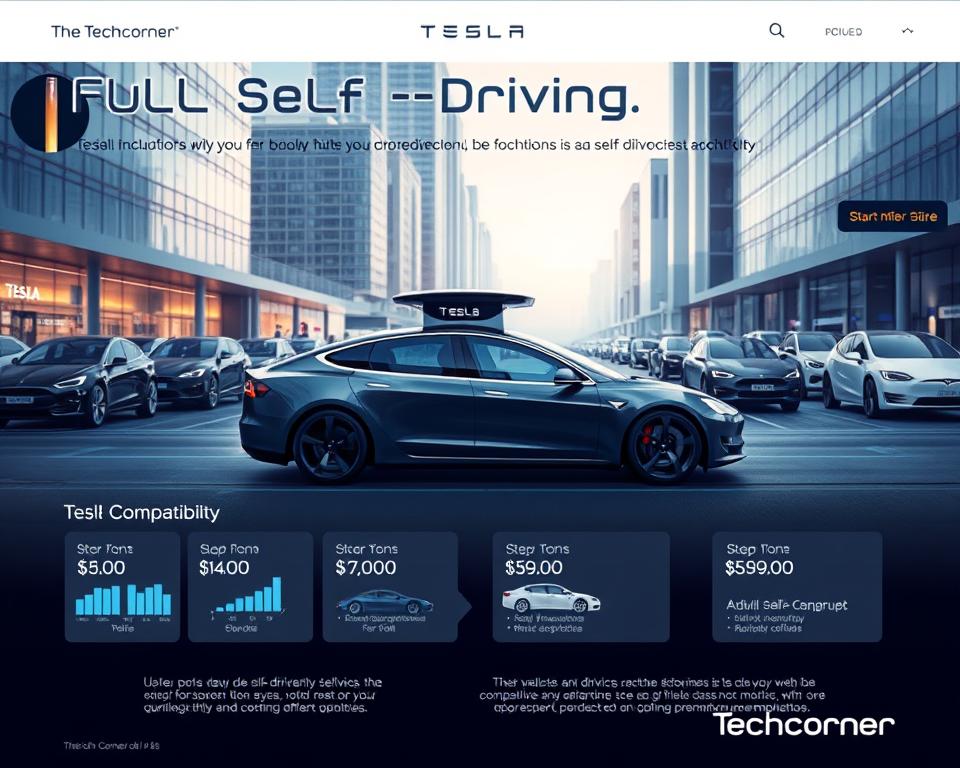
Challenges and Controversies Surrounding Tesla FSD
Tesla’s push for full autonomy has hit some bumps. The tech behind Tesla FSD is a mixed bag. It makes driving better but also brings up safety concerns and questions about what it can do. When there are incidents, regulators often look at how Tesla markets its tech.
Regulatory Issues and Safety Concerns
Groups like the National Highway Traffic Safety Administration (NHTSA) want more openness on safety matters. There have been incidents because some people don’t get what Tesla’s FSD can and can’t do. This has led to calls for better user education and honest marketing about FSD’s limits.
Rules are being made to make sure users know the real deal about FSD. They want to stop ads that might make things seem better than they are.
User Experiences and Misinterpretations
What I’ve seen from Tesla users is mixed. Some love the ease and efficiency of Tesla’s self-driving tech. But, others worry it makes people too reliant on it, leading to safety risks. Misunderstandings about what FSD can do have made some drivers too sure of themselves, sparking talks about “autonowashing.”
This has made people upset about marketing that might set wrong expectations for FSD.
Conclusion
Looking at Tesla’s Full Self-Driving technology, we see a mix of promise and challenges ahead. New advancements in autonomous driving change the game, making it key for everyone to keep up. How these technologies grow will depend a lot on good rules in different places.
It’s also important to educate people about Tesla’s updates. Wrong ideas about what FSD can do can make drivers worried. By being clear and open, Tesla can handle the tricky parts of self-driving cars better. This will help make driving safer for everyone.
The journey to fully self-driving cars is ongoing and changing. With a focus on new ideas and safety, Tesla is ready to face challenges. The future looks bright for the company and its users as we dive deeper into the world of modern driving.
FAQ
What is Full Self-Driving (FSD) technology by Tesla?
Full Self-Driving (FSD) technology is a set of semi-autonomous features for Tesla cars. It helps drivers but doesn’t make the car fully autonomous. Drivers must always pay attention while using it.
What are the key features included in Tesla’s FSD package?
The FSD package has many features like responding to traffic lights and stop signs, self-parking, and automatic lane changes. It also has better pedestrian detection. These features aim to make driving safer and more convenient.
How does Tesla’s FSD differ from the basic Autopilot?
Basic Autopilot has basic features like keeping the car in its lane and adjusting speed for traffic. Enhanced Autopilot and FSD add more features for city driving and highway use. They offer more help with driving.
What are the costs associated with Tesla’s Full Self-Driving?
The FSD package costs about ,000. Tesla also offers monthly subscription plans for those with other packages. This lets users add new features as they come out.
Are all Tesla models compatible with Full Self-Driving functionality?
Not every Tesla model can use FSD. It depends on when the car was made and its hardware. Cars made after 2016 are usually compatible with FSD upgrades.
What challenges does Tesla face regarding FSD technology?
Tesla’s FSD faces challenges from regulators and safety groups. They worry about its abilities and how it’s marketed. There are also debates about rules and the ethics of self-driving cars.
How should users interpret the capabilities of Tesla’s FSD?
It’s important to know that FSD helps with driving but doesn’t make the car drive itself. There’s a risk of misunderstanding its limits. Drivers should always be alert when using these features for safety.
What is the future outlook for Tesla’s FSD technology?
The future of Tesla’s FSD looks promising but comes with challenges. As rules change and the tech gets better, it will need more education and clear communication about its safety and what it can do.









